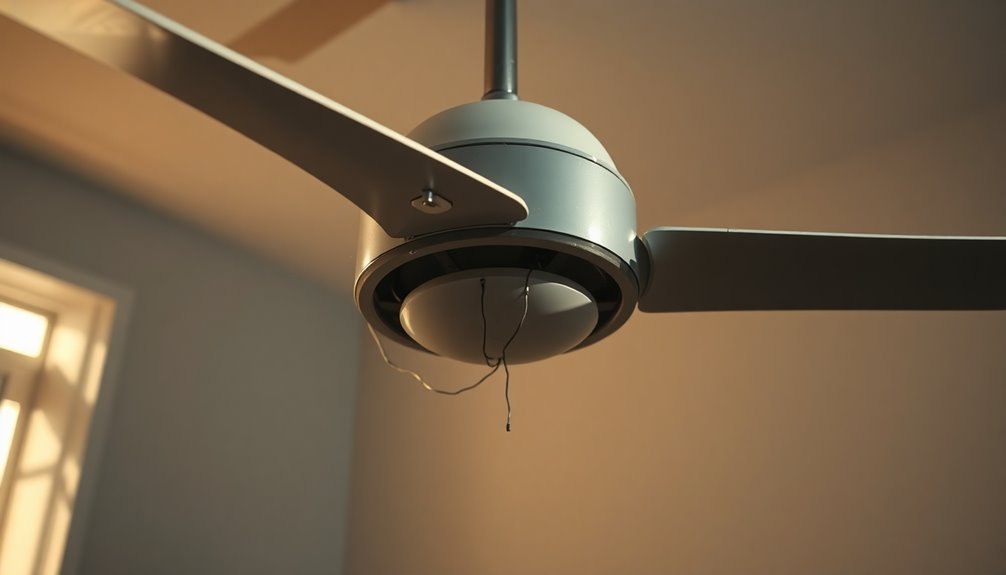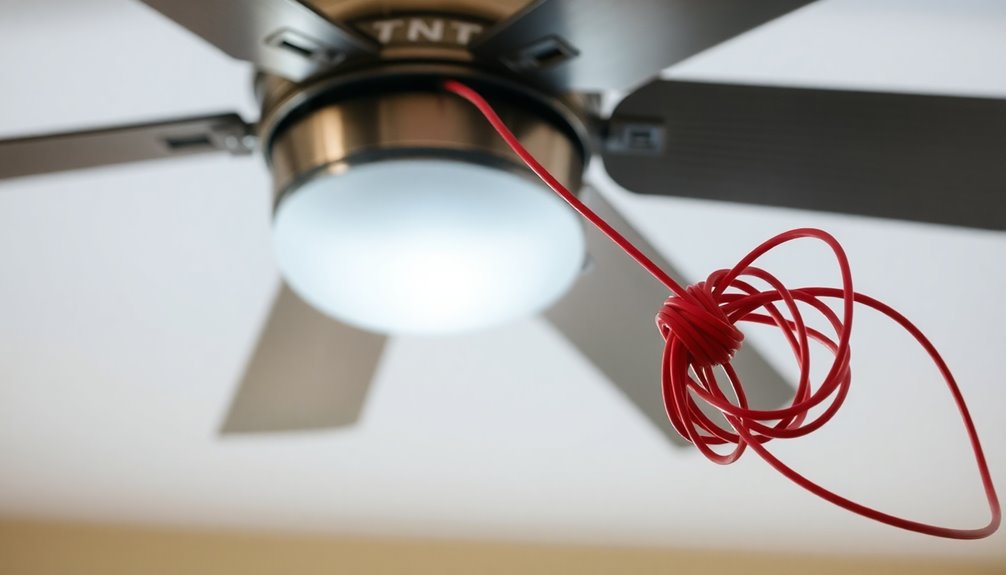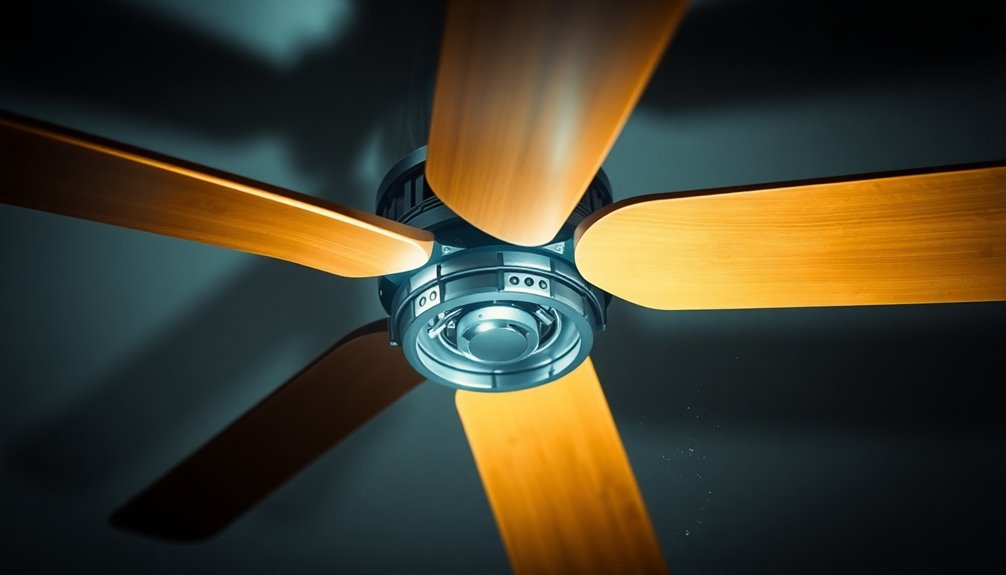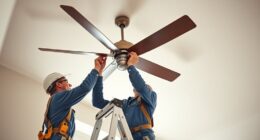Your ceiling fan might stop working due to several issues. First, check for power supply problems like tripped circuit breakers or loose wiring. If that's fine, examine the fan's components; faulty capacitors or damaged blades can lead to failure. It's also worth testing your remote control to verify it's working properly. If you hear unusual noises, the motor may be burnt out. Regular maintenance can help prevent these problems. If you're unsure about fixing it, seeking professional help is a smart move. Keep going to discover more about troubleshooting and maintaining your ceiling fan effectively.
Key Takeaways
- Power supply issues, such as tripped breakers or loose wiring, can prevent your ceiling fan from operating.
- Faulty components, like bad capacitors or damaged blades, may hinder fan performance.
- Electrical fluctuations can lead to insufficient power, causing the fan to stop unexpectedly.
- Motor burnout can result from overheating or lack of lubrication, indicating potential motor failure.
- Regular maintenance and inspections can help identify and prevent these issues before they cause malfunction.
Common Causes of Malfunction

Understanding why your ceiling fan stopped working can save you time and frustration. There are several common causes of malfunction that you should consider.
First, loose wiring connections can disrupt the power supply to your fan, preventing it from functioning at all. If the fan motor isn't receiving adequate power, it won't spin, leaving you without the cooling relief you need.
Another common issue is when the capacitor goes bad. This component is essential for the motor's operation, and if it fails, the fan won't work effectively.
Additionally, voltage fluctuations can lead to insufficient power supply, causing your fan to stop unexpectedly.
Don't overlook damaged fan blades, either. If they're imbalanced or broken, they can hinder performance, resulting in complete failure over time.
Finally, check your circuit breaker. A tripped breaker, often due to electrical surges, can cut off power to your ceiling fan, leaving you in the dark.
Electrical Troubleshooting Steps

When your ceiling fan stops working, taking a systematic approach to electrical troubleshooting can quickly pinpoint the issue. Start by checking the circuit breaker; if it's tripped, reset it to restore power.
Next, grab a multimeter to test the wall switch, ensuring it's functioning properly. A faulty switch might prevent the fan from receiving power.
Here are some key troubleshooting steps to follow:
- Inspect Wiring Connections: Open the fan's housing and check for loose or damaged wires that could disrupt power flow.
- Check the Remote Control: If your fan uses a remote, replace the batteries and make sure it's paired correctly with the receiver.
- Conduct a Visual Inspection: Look for signs of burning or damage on the fan and its components, as these may indicate electrical problems that need immediate attention.
Inspecting the Ceiling Fan Motor

After addressing potential electrical issues, it's time to inspect the ceiling fan motor itself. Start by checking for loose wiring connections. If you notice any loose or damaged wires, that could disrupt the power flow and prevent your fan from operating.
Next, look for burnt capacitors, which are essential for starting and running the motor effectively. If these capacitors are damaged, the ceiling fan motor won't function properly.
You should also inspect the motor for any signs of overheating, which can occur if internal components are damaged or if there's insufficient lubrication. Overheating can lead to motor failure, so ensuring that everything is in good shape is imperative.
Regular cleaning of the motor, including the ball bearings, can greatly enhance performance and longevity. Dust and debris can impede smooth operation, so don't skip this step.
If your fan still doesn't work after these checks, use a circuit tester to confirm that the wiring is intact and functioning properly.
Issues With Fan Speed Control

Fan speed control issues can be frustrating and may stem from several underlying problems. When your ceiling fan isn't responding as it should, it's vital to identify the root cause for effective ceiling fan troubleshooting. Here are some common culprits:
- Faulty capacitors: These components can prevent your fan from operating at all speeds, leading to complete failure.
- Worn-out motors: If the motor is wearing down, it mightn't respond accurately to your speed settings, resulting in inconsistent performance.
- Malfunctioning fan switch: A switch that's not working properly can disrupt the speed control mechanism, leaving you with limited or no fan speeds.
Additionally, wiring issues, such as loose or damaged connections, can considerably affect signal transmission to the motor, causing irregular speed performance.
An inconsistent power supply due to voltage fluctuations can also lead to improper fan operation.
To resolve these fan speed control issues, it's important to systematically check each component, ensuring that everything is functioning correctly. By pinpointing the problem, you can restore your ceiling fan to ideal performance.
Checking Wiring Connections

When your ceiling fan stops working, checking the wiring connections is essential.
Start by inspecting for any loose wires or signs of damage that could disrupt power flow.
Then, verify the integrity of the connections to guarantee everything's tight and functioning properly.
Inspect Loose Connections
One of the most common issues that can cause your ceiling fan to stop working is loose wiring connections. These loose connections can disrupt the power to your fan, leading to frustrating electrical issues.
To effectively troubleshoot this problem, it's important to inspect the wiring connections at both the fan and wall switch. Here are some key steps to follow:
- Check for corrosion or damage: Verify all connections are secure and free from any signs of wear.
- Use a circuit tester: This tool can help you confirm if there's power reaching the fan.
- Regularly tighten connections: Prevent future issues by making it a habit to check your fan's wiring.
If you find any loose connections, remember to turn off the power at the circuit breaker before making any adjustments. This not only safeguards you from potential hazards but also guarantees that you're addressing the wiring issue safely.
Using a multimeter to check for continuity can also be helpful, as a lack of continuity may indicate that you need to tighten or replace connections.
Following these troubleshooting tips will help restore your ceiling fan's functionality.
Verify Wiring Integrity
After checking for loose connections, the next step is to verify the integrity of the wiring. Inspect all wiring connections within the fan housing and at the switch to confirm they're secure and undamaged. Loose screws can disrupt the power flow, leading to malfunctions. Look closely for any frayed wires or broken connections, as these can cause shorts, preventing your ceiling fan from operating properly.
To effectively check continuity in the wiring, use a multimeter. This device can help you identify any disconnected or faulty connections. When you set the multimeter to the continuity setting, you can easily determine if the current can flow through the wires. If you find that some wires aren't conducting electricity, it's vital to address these issues immediately.
Regularly checking and maintaining wiring integrity is essential for extending the lifespan of your ceiling fan and improving its performance. By confirming that all connections are tight and free from damage, you can avoid future problems and keep your fan running smoothly.
Don't overlook this step; it can save you time and money on repairs down the line.
Test Power Supply
To guarantee your ceiling fan receives power, start by checking the circuit breaker; a tripped breaker can interrupt the electrical supply.
If you find the circuit is fine but your ceiling fan is still not working, it's time to test the power supply. This involves inspecting the wiring connections to verify everything is secure and intact.
Here's what you should do:
- Check circuit breaker: Look for any tripped breakers that might cut power to the fan.
- Inspect wiring connections: Verify there are no loose or damaged wires that could disrupt the flow of electricity.
- Use a voltage tester: Test the voltage at the fan's connection points to confirm it meets the required levels.
Don't forget to check any remote controls or wall switches too.
Faulty switches can prevent power from reaching the fan, causing it to stop working altogether.
Remember, if the wiring is hardwired, inspect the electrical wires leading to the fan for any signs of wear or damage.
These steps will help you determine if the power to the fan is compromised and assist you in resolving the issue effectively.
Identifying Lighting Problems

When dealing with a ceiling fan that has lighting issues, start by checking the bulbs. Make certain they're properly installed and not burnt out, as even one faulty bulb can cause the entire lighting fixture to fail. If the bulbs seem fine, inspect the bulb socket for any burn marks or signs of damage, which may indicate a deeper wiring problem.
Next, check for loose connections in the lighting fixture. Loose connections can disrupt the electrical flow and lead to malfunctioning lights. It's also wise to verify that the light switch is functioning correctly. Use a voltage tester to confirm that power is reaching the fixture.
If the fan operates but the lights don't, consider these solutions in the table below:
| Problem | Solution |
|---|---|
| Burn marks in socket | Inspect wiring, replace socket |
| Loose connections | Tighten connections |
| Non-working bulbs | Replace bulbs |
| Light switch issue | Test or replace switch |
| Entire light kit failure | Consider replacing light kit |
Noisy Fan Operation Solutions

If your ceiling fan's lights are functioning but the fan itself is making unsettling noises, it's time to troubleshoot further. Noisy ceiling fans can often be traced back to a few common issues. Here are some steps you can take to resolve the problem:
- Tighten Loose Screws: Check all screws and components to guarantee they're securely fastened. Loose screws can cause rattling and vibrations.
- Lubricate Ball Bearings: Worn bearings can increase friction and contribute to noise. Lubricating them can help reduce sound and improve performance.
- Inspect for Foreign Objects: Make sure there are no foreign objects obstructing the fan blades. Debris can create unwanted noise during operation.
Additionally, verify the fan is properly balanced. An unbalanced fan will wobble and create noise. Use a level to check alignment and consider adding weights to the blades if needed.
Finally, don't forget to consult the manufacturer's troubleshooting guide for model-specific advice on noise issues. By following these steps, you can restore your fan's quiet operation and enjoy a more peaceful environment.
Remote Control Troubleshooting

Experiencing issues with your ceiling fan's remote control can be frustrating, but troubleshooting is often straightforward.
Start by checking the batteries in your remote control. It's common for dead batteries to cause problems, so if it's not working, replace batteries first.
Next, verify that you're pairing the remote correctly with the fan's receiver. Sometimes, resetting or reprogramming the remote is necessary to establish a connection.
If your remote still doesn't respond, inspect the remote control receiver located in the fan's mounting bracket. Look for signs of receiver damage or any loose connections that could interfere with functionality.
If you find any issues, you may need to replace the remote or the receiver, as these components can wear out over time.
Lastly, if your ceiling fan has pull chains, make certain the speed setting is on high. This can directly impact remote control operation. Additionally, ensure that your fan is Energy Star certified, as this can enhance overall performance and efficiency.
By following these steps, you can often resolve remote control issues and get your ceiling fan working again.
If all else fails, it might be time to contemplate a replacement remote.
Maintenance and Care Tips

To keep your ceiling fan running smoothly and efficiently, regular maintenance is essential. By taking the time to care for your fan, you can enhance its performance and prolong its lifespan.
Here are some key tips to help you maintain your ceiling fan:
- Clean the fan blades and motor housing regularly to prevent dust buildup, which can impair performance and cause overheating. Regular cleaning can also improve indoor air quality, allowing your fan to circulate air more effectively.
- Inspect and tighten screws and connections periodically to verify all components are secure and functioning properly.
- Lubricate the ball bearings and other moving parts to minimize friction and reduce noise during operation.
Additionally, make sure to test the fan's functions, including speed settings and direction changes, at least once a month. This will help you catch any issues early.
It's also a good idea to schedule professional maintenance annually. A professional can help guarantee peak performance and safely address any potential electrical or mechanical issues. Regular maintenance can also improve energy efficiency and reduce your overall energy consumption, ensuring your ceiling fan operates at its best.
When to Seek Professional Help

If your ceiling fan shows signs of complex issues, like humming noises or non-spinning blades, it's time to contemplate professional help.
Ignoring safety protocols can lead to more damage or hazards, so don't hesitate to call in an expert.
Getting professional service not only resolves the problem but also guarantees your fan operates safely and efficiently for years to come.
Signs of Complex Issues
Noticing your ceiling fan struggling to function can be frustrating, especially when the blades remain still despite the motor running. This often points to complex issues that require professional help.
If you encounter any of the following signs, it's time to call in an expert:
- A humming or buzzing sound without blade movement suggests loose wiring or defective components.
- Overheating issues, like a burning smell or excessive heat from the motor, indicate a serious problem that needs immediate attention.
- If basic troubleshooting, like resetting the circuit breaker or addressing remote control malfunctions, doesn't resolve the issue, don't hesitate to seek professional assistance.
Dealing with complex electrical problems, such as a malfunctioning motor or control circuit board, is best left to licensed professionals.
They've the expertise to diagnose and fix the underlying issues safely. Ignoring these signs could lead to further damage or even fire hazards.
Safety Protocols to Follow
Your ceiling fan's safety should always be a top priority, especially when issues arise that require professional help. If you've already tried basic troubleshooting—like checking the power supply and connections—and your fan still isn't working, it's time to contemplate more complex electrical problems.
Always turn off the power at the circuit breaker before inspecting or repairing any electrical components to guarantee your safety.
Listen for unusual noises, such as buzzing or humming, which could indicate loose wiring or a failing fan motor. These signs often mean you need a licensed electrician to assess the situation.
If you detect overheating in the fan motor or notice any burning smells, seek professional help immediately. These symptoms can signal serious internal issues that pose fire hazards.
Regular maintenance by a licensed professional can help you identify potential problems early on, guaranteeing your ceiling fan operates safely and efficiently.
Don't ignore the importance of safety when dealing with electrical systems—taking the right steps now can save you time, money, and potential risks down the line.
Always prioritize your safety and the integrity of your home's wiring.
Benefits of Professional Service
When dealing with ceiling fan issues, knowing when to call in a professional can save you time, money, and hassle.
If your ceiling fan stopped working, it's crucial to evaluate the benefits of professional service. Licensed electricians have the expertise to diagnose complex electrical problems that might go beyond your troubleshooting abilities. They can identify and replace faulty components, guaranteeing your fan operates safely and efficiently.
Here are three situations when you should contact a licensed electrician:
- Faulty Components: If you suspect issues like a malfunctioning capacitor or motor, a professional can repair or replace these parts correctly.
- Regular Maintenance: Scheduling regular maintenance can help extend the lifespan of your ceiling fan, preventing future breakdowns.
- Warranty Coverage: For newer fans, utilizing a professional service guarantees your warranty remains intact. Unauthorized repairs might void your manufacturer's guarantees.
Frequently Asked Questions
Why Is My Ceiling Fan Suddenly Not Working?
If your ceiling fan's suddenly not working, it's time to troubleshoot.
First, check for any tripped circuit breakers; a simple reset might do the trick.
Next, inspect the fan's wiring connections for looseness or damage.
If you notice any strange noises, it could be a sign of burnt capacitors or imbalanced blades.
Finally, verify your power supply's stable, as fluctuations can prevent proper operation.
Don't hesitate to call an electrician if needed!
How Do You Reset a Ceiling Fan?
Resetting a ceiling fan is as simple as flipping a switch. Start by turning off the power at the circuit breaker for safety.
Check for a reset button on the motor housing; pressing it might bring your fan back to life. If you use a remote, pop out the batteries and reinsert them.
For fans with a reversing switch, toggle it a few times. Restore power and test all functions to verify everything's working smoothly!
Why Did the Fan Suddenly Stop Working?
If your fan suddenly stops working, it might be due to several issues.
Check for loose wiring connections that could disrupt power flow. If the motor isn't starting, burnt capacitors might be the culprit.
You should also inspect the circuit breaker—if it's tripped, reset it.
Additionally, imbalanced or damaged blades can cause problems, and voltage fluctuations might prevent your fan from receiving enough power to operate efficiently.
How Do I Know if My Ceiling Fan Motor Is Broken?
If your ceiling fan's taken a little vacation, it might be time to investigate its motor.
You'll notice signs like a complete standstill, unusual buzzing sounds, or even a bit of overheating. Pay attention to how it responds to speed adjustments; inconsistency can hint at trouble.
To confirm its status, grab a multimeter and check for power. If it's not receiving any, and everything's connected, the motor might just need some TLC—or a replacement.
Conclusion
In the grand symphony of home comfort, a silent ceiling fan can feel like a sudden pause in the music. By following these troubleshooting steps, you can often restore the rhythm and enjoy a cool breeze once again. Remember, just like any great maestro, patience and care are key. If your fan still won't play nice after your efforts, don't hesitate to call in the professionals to bring back the harmony you deserve.









